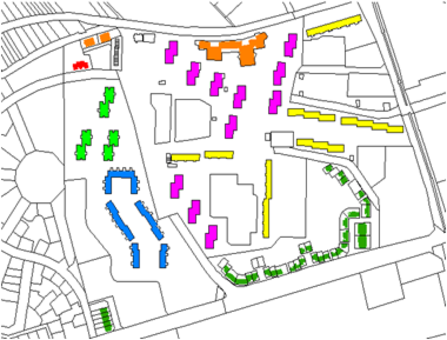HU Hungary - Scenario Results and Monitoring Approaches
National Contact Point
| Information in Hungarian language: | National Contact Point Hungary |
Monitoring of Housing Stock in a Defined Local Area
|
Download Report on Local Case Study Hungary |
Download EPI Tables Local Case Study Hungary |
Last updated: 30.05.2016
Scope
| Scale | No. of dwellings | No. of buildings | No. of inhabitants | m² reference area |
|---|---|---|---|---|
| Local | 10,876 | 6,033 | 27,655 | 1,311,000 (net floor area) |
Description of the action
The objectives of this Pilot Action were the following:
(1) Tracking refurbishment rates and progress in energy saving through an area-based approach. Gathering data about the building stock of the test area in particular on the current state of the art of the buildings. Data sources: GIS systems, database of the local government (mainly public buildings) and that of the housing association. Determination of the current retrofit rates on the bases of selected completed or ongoing projects and taking into account national standards.
(2) Identifying the efforts required for refurbishment to NZEB levels by mapping typologies
(3) Elaborate a guidance for local stakeholders and other housing companies, municipalities and national stakeholders.

Results
To model potential future states, we have investigated 3 scenarios (Trend, B and C, with increasing commitment to refurbishments and NZEB standards). In summary, our results show that even the most ambitious scenario is insufficient to achieve 2050 targets (although 2030 target can be met this way). It should be noted that the 2050 values are only indicative – there are no nationally approved targets at the time of this writing. The main reason for this is the considerable increase in building stock over the assessed period (by roughly 25 %). The area selected for the pilot is in a unique position – such an expansion of the building stock is not expected elsewhere, therefore it may be reasonable to:
a) Define less ambitious target for Budaörs
b) Be slightly more optimistic in terms of meeting the 2050 goals on a national level
According to our analysis, the targets set for 2050 could only be reached with a refurbishment rate well over 3 % (referring to the gross floor area of the buildings and assuming a refurbishment on an ambitious level), which is unrealistic, even for a relatively wealthy town such as Budaörs.
Links
Budaörs website: http://www.budaors.hu/en/
Budaörs interactive map: http://budaors.holvan.hu/
Last updated: 19.10.2015
| Responsible for the content of this page: BME - Budapest University of Technology and Economics, Department of Environmental Economics (contact information) |















